2002 LAND ROVER DISCOVERY lock
[x] Cancel search: lockPage 1026 of 1672

REAR SUSPENSION
DESCRIPTION AND OPERATION 64-21
Normal ride height
When the vehicle is stationary, a door is open and the ignition is off, the SLS system will allow the rear of the vehicle
to lower to within 20 mm of the normal ride height as load is removed from the vehicle. The SLS system will only
operate the compressor to raise the rear of the vehicle when the engine is running, unless requested using the remote
handset.
Off-road mode (ORM)
ORM is used to raise the rear of the vehicle from normal ride height to the ORM ride height of 100 mm between the
tip of the bump stop and the axle.
ORM is activated by depressing the ORM switch located on the fascia for not less than 0.5 seconds. With the engine
running, all doors closed and the vehicle speed below 18 mph (30 km/h), the audible warning will sound once and the
ORM warning lamp in the instrument pack will start to flash when the switch is released. The compressor will be
started and the air control valves will be energised by the ECU to inflate the air springs and raise the rear of the vehicle.
When the full ORM height is reached, the ECU will terminate compressor operation and close the air valves. The ORM
warning lamp will stop flashing and remain continuously illuminated to inform the driver that the SLS system is in ORM.
When ORM is no longer required, depressing the ORM switch for not less than 0.5 seconds with all doors closed will
lower the SLS to normal ride height. The audible warning will sound once and the ORM warning lamp will flash as the
suspension lowers. The ECU energises the air control valves and the exhaust valve to release air pressure from the
air springs. When standard ride height is reached the ORM warning lamp will extinguish and the ECU will de-energise
the air control valves and the exhaust valve solenoids.
If the SLS is in ORM and the vehicle speed exceeds 18 mph (30 km/h), the ECU will lower the SLS to standard ride
height. The driver will be informed of this by an audible warning and the ORM warning lamp flashing as the suspension
lowers. When normal ride height is achieved, the ORM warning lamp will extinguish.
At sea level, the time to change the SLS from normal ride height to ORM or visa versa will take between 15 and 20
seconds.
If the ECU determines that conditions are not correct for SLS operation, i.e.; axle articulation or system fault, the
audible warning will sound three times to inform the driver that the ORM request has not been granted.
Extended mode
The extended mode is automatically operated by the ECU and requires no input from the driver. Extended mode
operates when the chassis is grounded causing the rear wheels to spin. This information is generated by the ABS
function of the SLABS ECU.
When the ECU senses that the chassis is grounded and the vehicle speed is less than 6 mph (10 km/h), the ECU will
operate the compressor and energise the air control valves for 25 seconds to raise the rear of the vehicle. This
operates irrespective of the mode that the SLS system is in at that time. To inform the driver, the ORM warning lamp
will flash continuously at all times that the system is in extended mode.
The driver can exit the extended mode by depressing the ORM switch for not less than 0.5 seconds or by exceeding
8 mph (13 km/h).
Remote handset SLS control
The remote handset is an accessory item which allows the SLS to be operated between normal ride height and bump
stop height to allow easier connection and disconnection of trailers. The remote handset is similar in appearance to
that of the remote door locking handset but does not have an integral key. A circular button with an arrow is used to
raise the SLS and an oval button with the 'Land Rover' logo is used to lower the SLS.
The remote handset control requires all doors to be closed and the ignition to be in position II, but the engine does
not need to be running.
Page 1028 of 1672
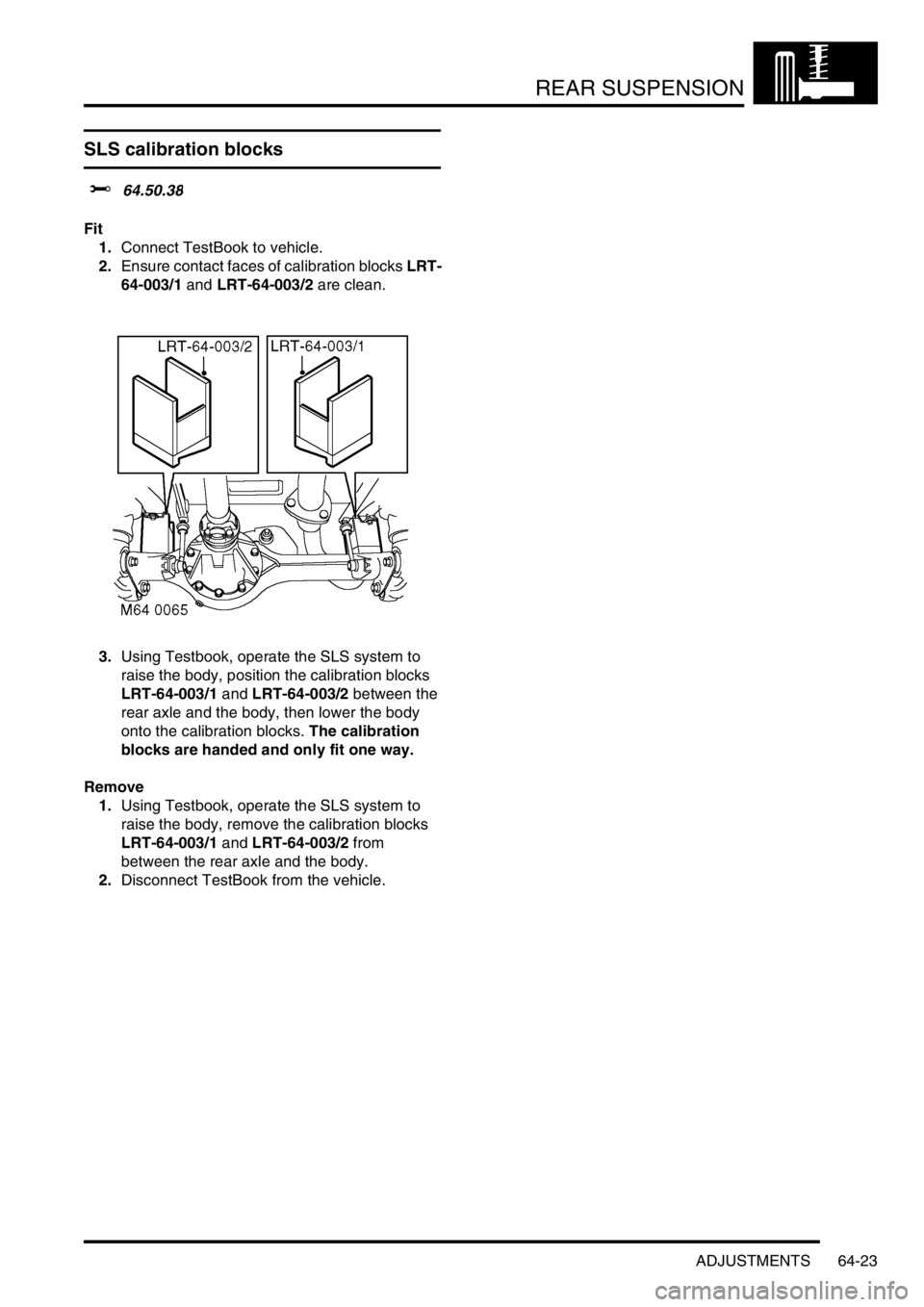
REAR SUSPENSION
ADJUSTMENTS 64-23
ADJUST ME NTS
SLS calibration blocks
$% 64.50.38
Fit
1.Connect TestBook to vehicle.
2.Ensure contact faces of calibration blocks LRT-
64-003/1 and LRT-64-003/2 are clean.
3.Using Testbook, operate the SLS system to
raise the body, position the calibration blocks
LRT-64-003/1 and LRT-64-003/2 between the
rear axle and the body, then lower the body
onto the calibration blocks. The calibration
blocks are handed and only fit one way.
Remove
1.Using Testbook, operate the SLS system to
raise the body, remove the calibration blocks
LRT-64-003/1 and LRT-64-003/2 from
between the rear axle and the body.
2.Disconnect TestBook from the vehicle.
Page 1033 of 1672
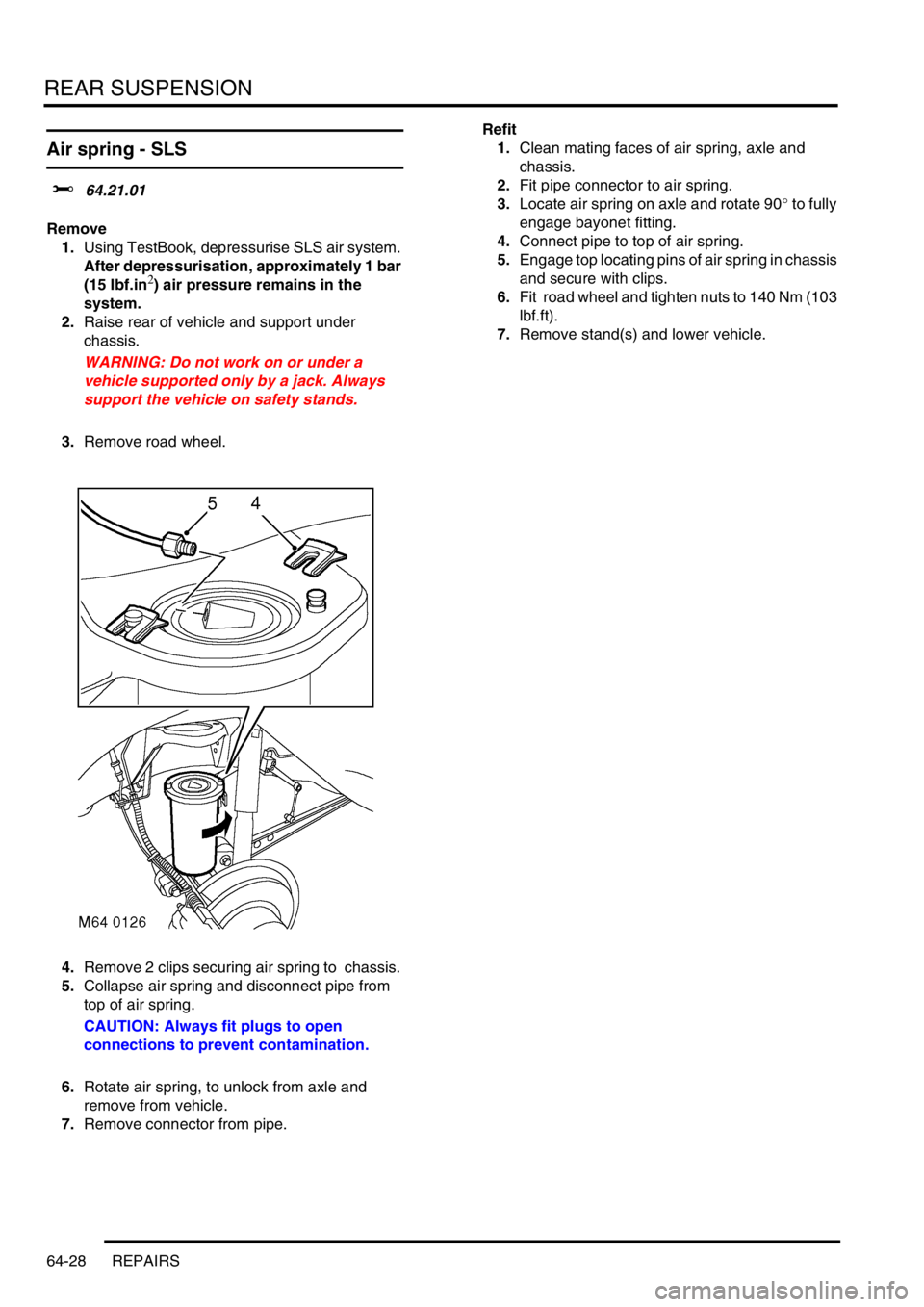
REAR SUSPENSION
64-28 REPAIRS
Air spring - SLS
$% 64.21.01
Remove
1.Using TestBook, depressurise SLS air system.
After depressurisation, approximately 1 bar
(15 lbf.in
2) air pressure remains in the
system.
2.Raise rear of vehicle and support under
chassis.
WARNING: Do not work on or under a
vehicle supported only by a jack. Always
support the vehicle on safety stands.
3.Remove road wheel.
4.Remove 2 clips securing air spring to chassis.
5.Collapse air spring and disconnect pipe from
top of air spring.
CAUTION: Always fit plugs to open
connections to prevent contamination.
6.Rotate air spring, to unlock from axle and
remove from vehicle.
7.Remove connector from pipe.Refit
1.Clean mating faces of air spring, axle and
chassis.
2.Fit pipe connector to air spring.
3.Locate air spring on axle and rotate 90
° to fully
engage bayonet fitting.
4.Connect pipe to top of air spring.
5.Engage top locating pins of air spring in chassis
and secure with clips.
6.Fit road wheel and tighten nuts to 140 Nm (103
lbf.ft).
7.Remove stand(s) and lower vehicle.
Page 1037 of 1672
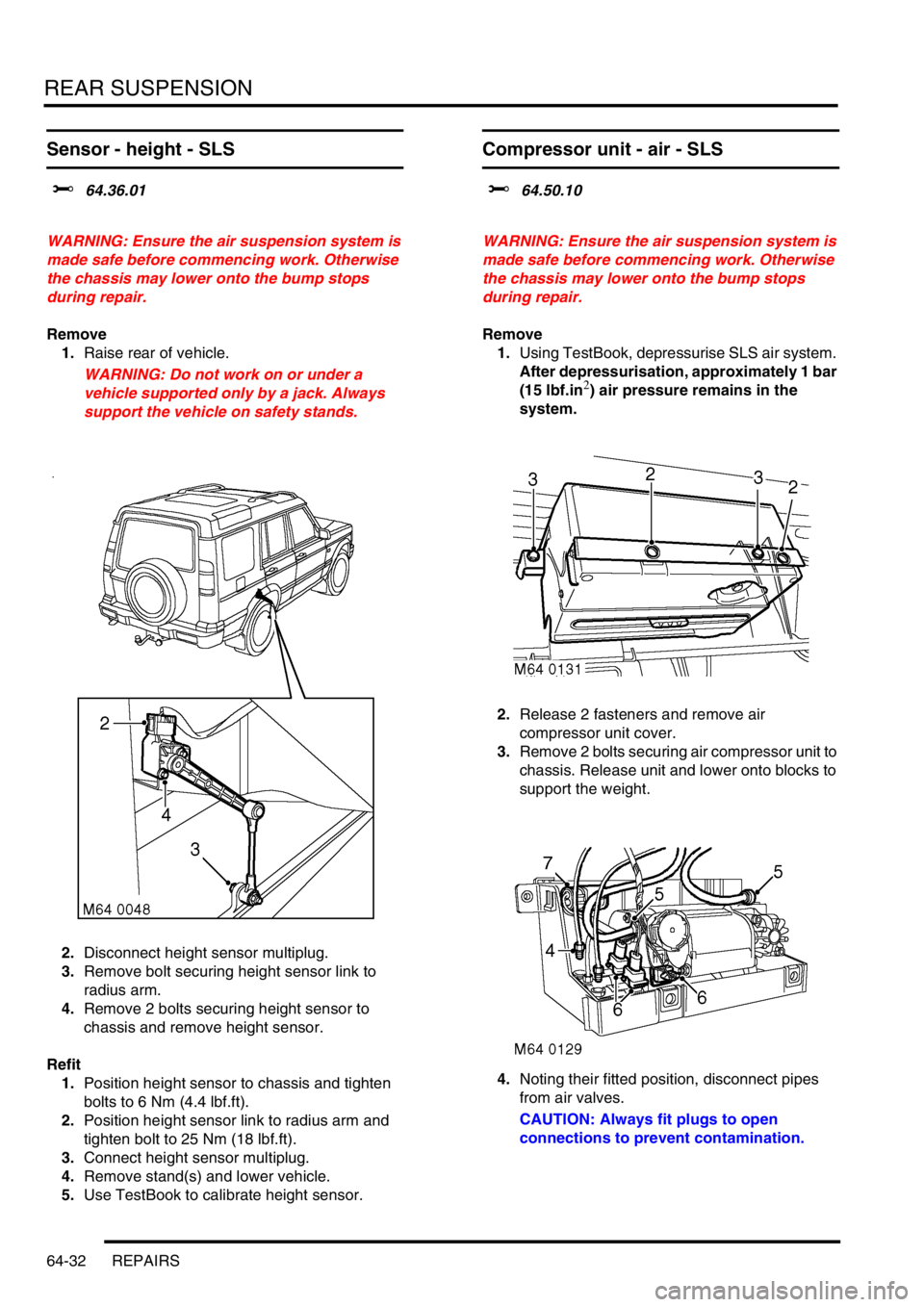
REAR SUSPENSION
64-32 REPAIRS
Sensor - height - SLS
$% 64.36.01
WARNING: Ensure the air suspension system is
made safe before commencing work. Otherwise
the chassis may lower onto the bump stops
during repair.
Remove
1.Raise rear of vehicle.
WARNING: Do not work on or under a
vehicle supported only by a jack. Always
support the vehicle on safety stands.
2.Disconnect height sensor multiplug.
3.Remove bolt securing height sensor link to
radius arm.
4.Remove 2 bolts securing height sensor to
chassis and remove height sensor.
Refit
1.Position height sensor to chassis and tighten
bolts to 6 Nm (4.4 lbf.ft).
2.Position height sensor link to radius arm and
tighten bolt to 25 Nm (18 lbf.ft).
3.Connect height sensor multiplug.
4.Remove stand(s) and lower vehicle.
5.Use TestBook to calibrate height sensor.
Compressor unit - air - SLS
$% 64.50.10
WARNING: Ensure the air suspension system is
made safe before commencing work. Otherwise
the chassis may lower onto the bump stops
during repair.
Remove
1.Using TestBook, depressurise SLS air system.
After depressurisation, approximately 1 bar
(15 lbf.in
2) air pressure remains in the
system.
2.Release 2 fasteners and remove air
compressor unit cover.
3.Remove 2 bolts securing air compressor unit to
chassis. Release unit and lower onto blocks to
support the weight.
4.Noting their fitted position, disconnect pipes
from air valves.
CAUTION: Always fit plugs to open
connections to prevent contamination.
Page 1038 of 1672
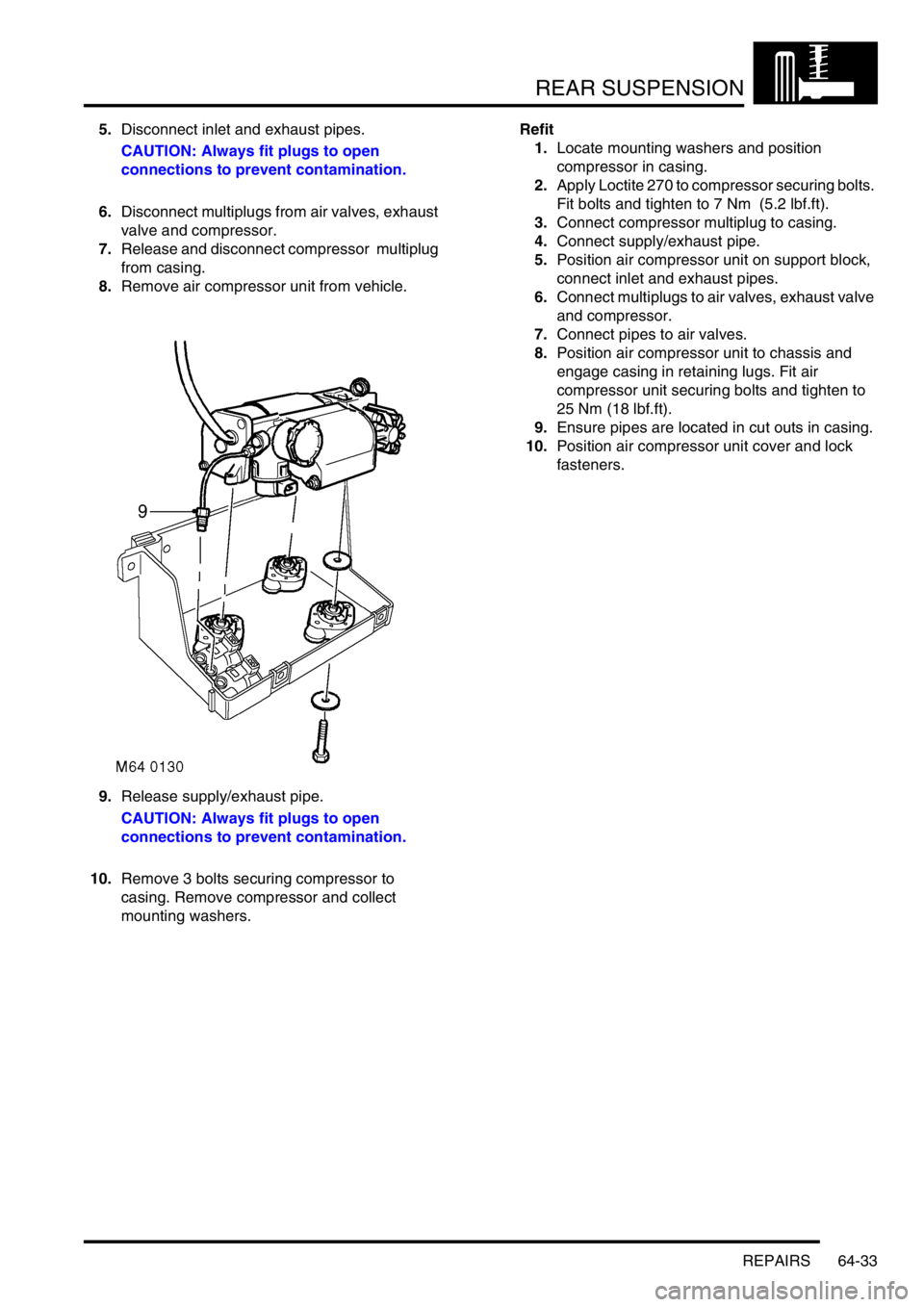
REAR SUSPENSION
REPAIRS 64-33
5.Disconnect inlet and exhaust pipes.
CAUTION: Always fit plugs to open
connections to prevent contamination.
6.Disconnect multiplugs from air valves, exhaust
valve and compressor.
7.Release and disconnect compressor multiplug
from casing.
8.Remove air compressor unit from vehicle.
9.Release supply/exhaust pipe.
CAUTION: Always fit plugs to open
connections to prevent contamination.
10.Remove 3 bolts securing compressor to
casing. Remove compressor and collect
mounting washers. Refit
1.Locate mounting washers and position
compressor in casing.
2.Apply Loctite 270 to compressor securing bolts.
Fit bolts and tighten to 7 Nm (5.2 lbf.ft).
3.Connect compressor multiplug to casing.
4.Connect supply/exhaust pipe.
5.Position air compressor unit on support block,
connect inlet and exhaust pipes.
6.Connect multiplugs to air valves, exhaust valve
and compressor.
7.Connect pipes to air valves.
8.Position air compressor unit to chassis and
engage casing in retaining lugs. Fit air
compressor unit securing bolts and tighten to
25 Nm (18 lbf.ft).
9.Ensure pipes are located in cut outs in casing.
10.Position air compressor unit cover and lock
fasteners.
Page 1040 of 1672
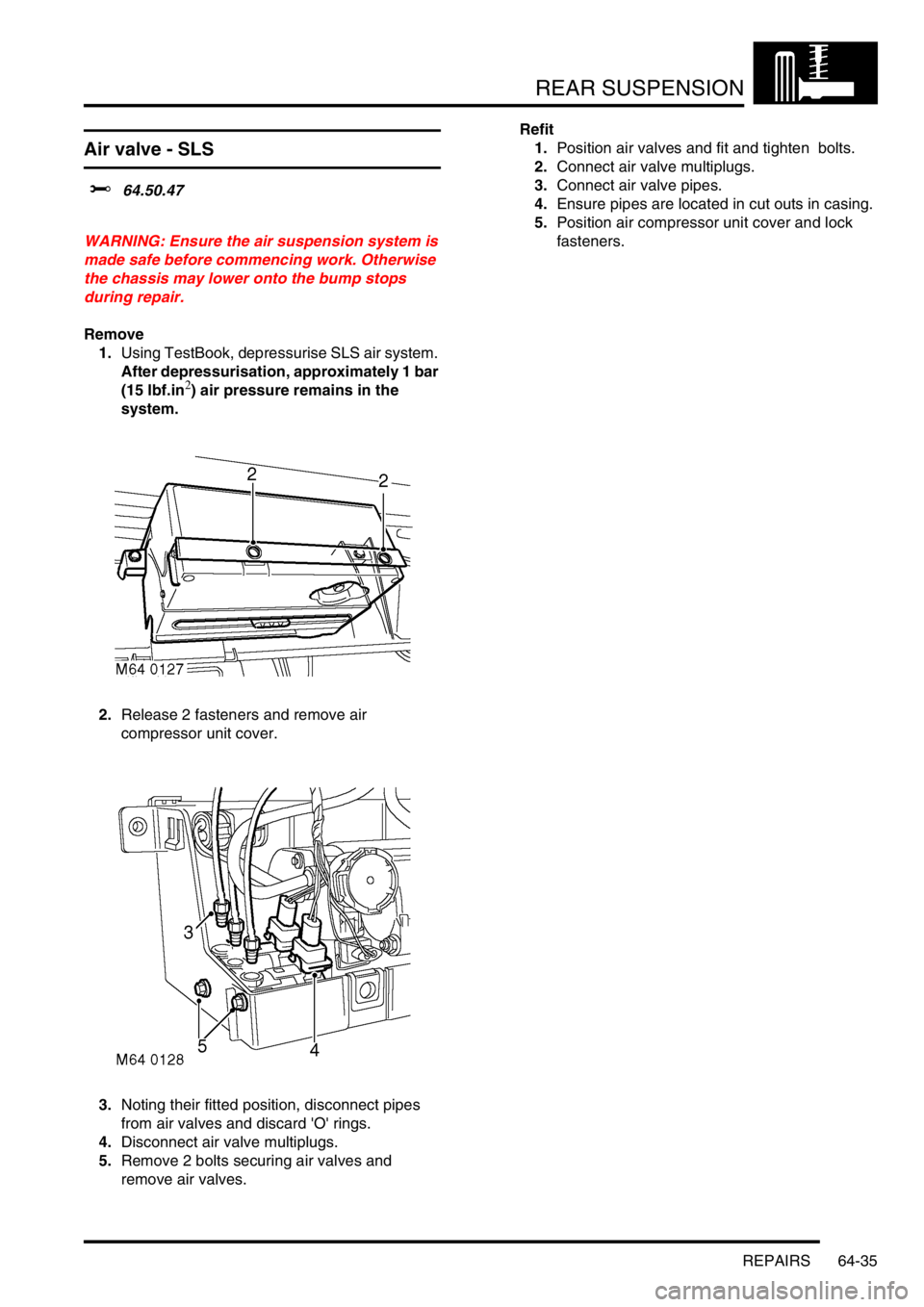
REAR SUSPENSION
REPAIRS 64-35
Air valve - SLS
$% 64.50.47
WARNING: Ensure the air suspension system is
made safe before commencing work. Otherwise
the chassis may lower onto the bump stops
during repair.
Remove
1.Using TestBook, depressurise SLS air system.
After depressurisation, approximately 1 bar
(15 lbf.in
2) air pressure remains in the
system.
2.Release 2 fasteners and remove air
compressor unit cover.
3.Noting their fitted position, disconnect pipes
from air valves and discard 'O' rings.
4.Disconnect air valve multiplugs.
5.Remove 2 bolts securing air valves and
remove air valves. Refit
1.Position air valves and fit and tighten bolts.
2.Connect air valve multiplugs.
3.Connect air valve pipes.
4.Ensure pipes are located in cut outs in casing.
5.Position air compressor unit cover and lock
fasteners.
Page 1048 of 1672

BRAKES
DESCRIPTION AND OPERATION 70-3
1ABS sensor
2ABS modulator
3Return pump relay
4SLABS ECU
5Brake lamp relay
6Centre high mounted stop lamp
7LH brake lamp
8RH brake lamp
9Instrument pack
10Body control unit
11Reverse lamp switch (manual gearbox)
12Diagnostic socket
13HDC switch
14Transmission high/low switch
15Centre differential lock switch
16Engine control module
17Battery power supply
18Ignition power supply
Page 1050 of 1672
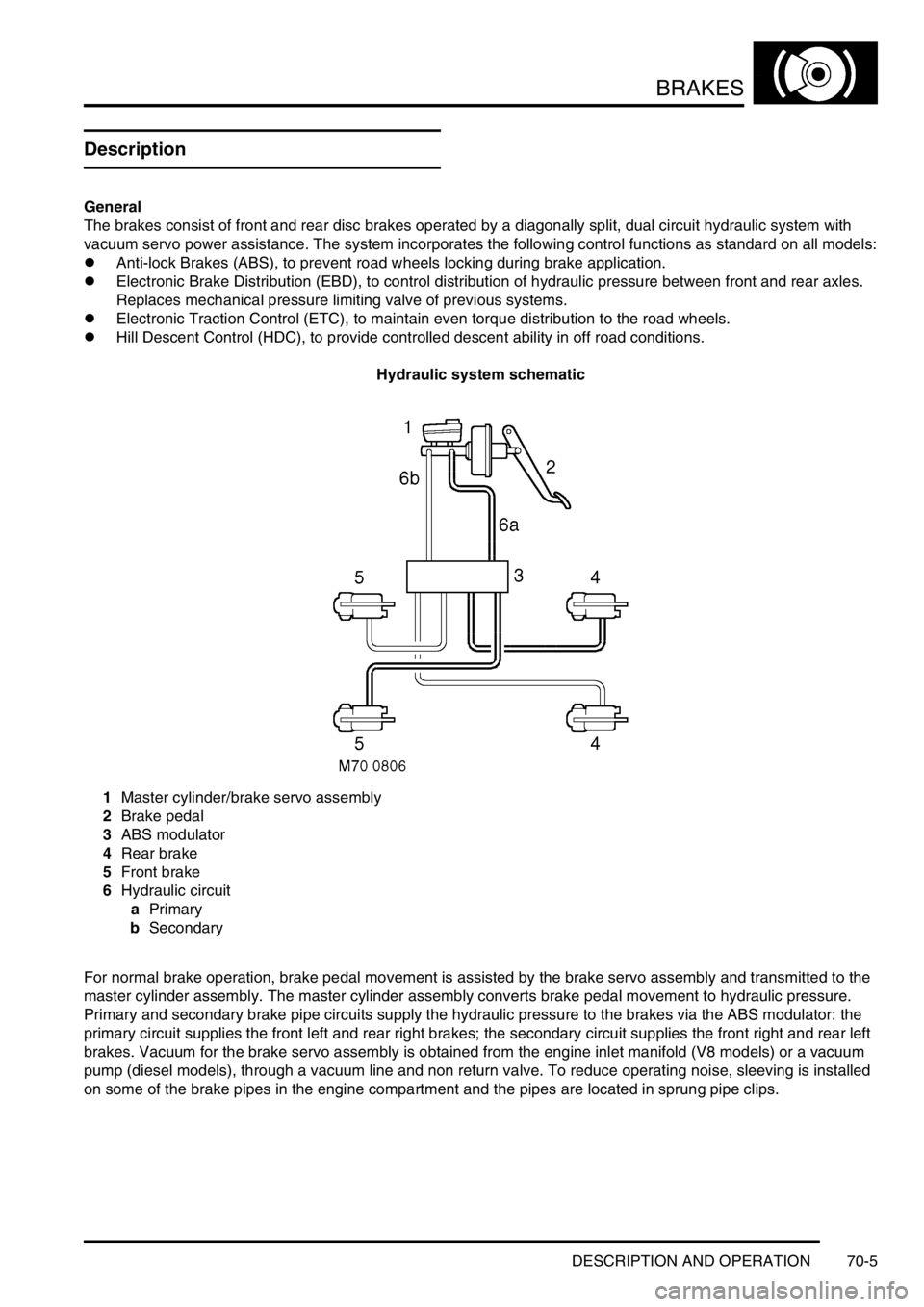
BRAKES
DESCRIPTION AND OPERATION 70-5
Description
General
The brakes consist of front and rear disc brakes operated by a diagonally split, dual circuit hydraulic system with
vacuum servo power assistance. The system incorporates the following control functions as standard on all models:
lAnti-lock Brakes (ABS), to prevent road wheels locking during brake application.
lElectronic Brake Distribution (EBD), to control distribution of hydraulic pressure between front and rear axles.
Replaces mechanical pressure limiting valve of previous systems.
lElectronic Traction Control (ETC), to maintain even torque distribution to the road wheels.
lHill Descent Control (HDC), to provide controlled descent ability in off road conditions.
Hydraulic system schematic
1Master cylinder/brake servo assembly
2Brake pedal
3ABS modulator
4Rear brake
5Front brake
6Hydraulic circuit
aPrimary
bSecondary
For normal brake operation, brake pedal movement is assisted by the brake servo assembly and transmitted to the
master cylinder assembly. The master cylinder assembly converts brake pedal movement to hydraulic pressure.
Primary and secondary brake pipe circuits supply the hydraulic pressure to the brakes via the ABS modulator: the
primary circuit supplies the front left and rear right brakes; the secondary circuit supplies the front right and rear left
brakes. Vacuum for the brake servo assembly is obtained from the engine inlet manifold (V8 models) or a vacuum
pump (diesel models), through a vacuum line and non return valve. To reduce operating noise, sleeving is installed
on some of the brake pipes in the engine compartment and the pipes are located in sprung pipe clips.